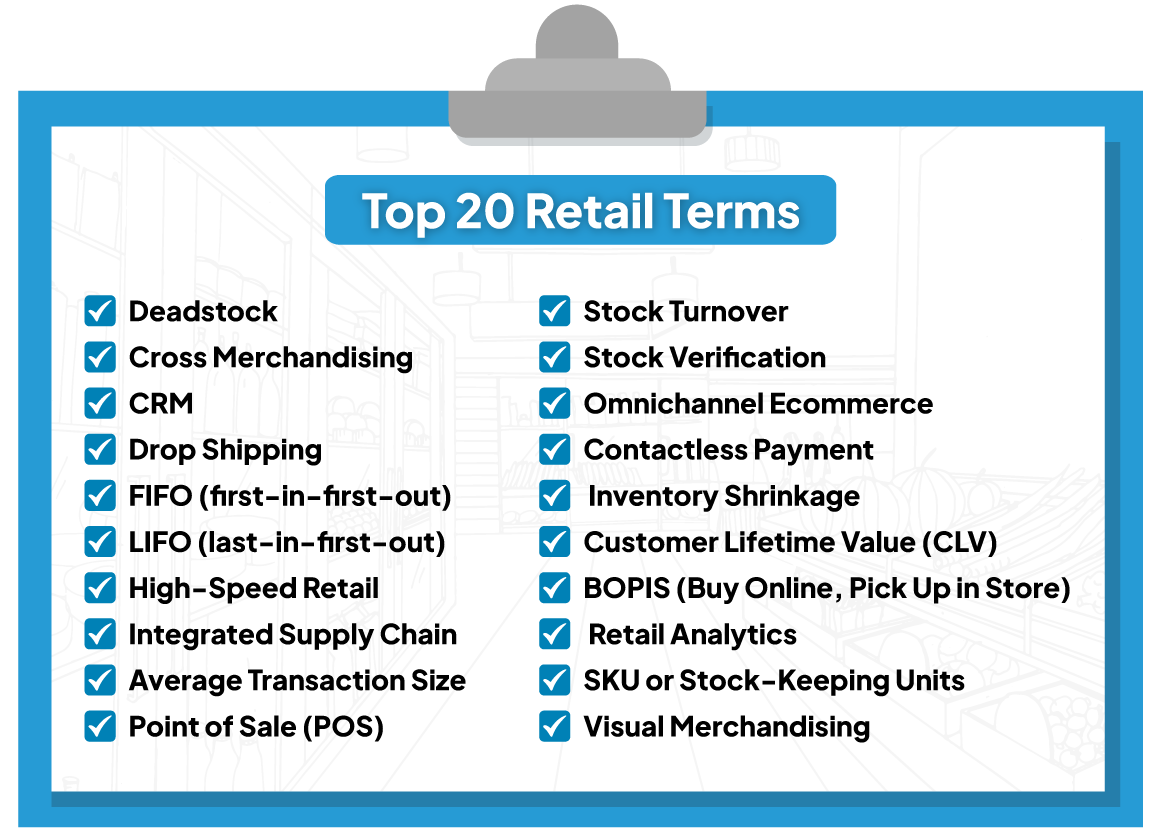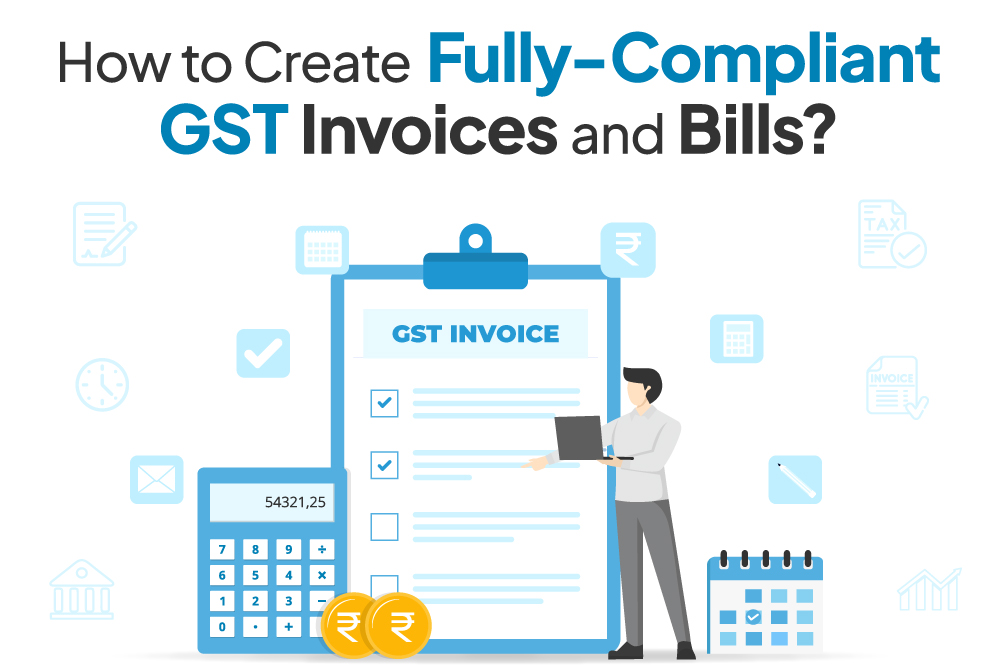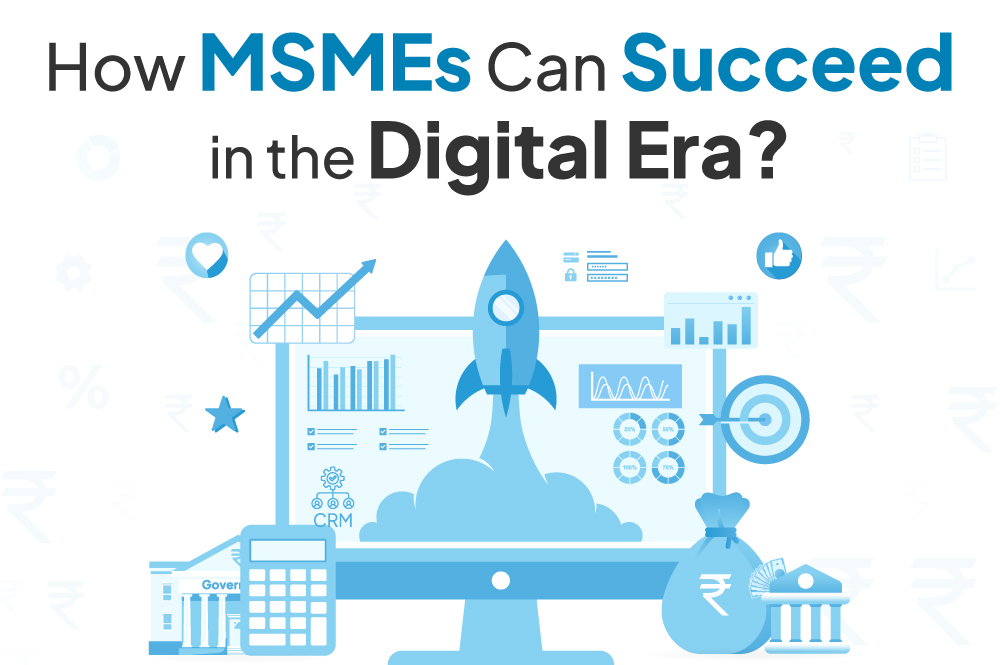20 Retail Management Terms Every Retailer Must Know
March 21, 2024

Running a business with solid retail terminology will take a lot of work. You can advance your business and make your operations run smoothly by understanding the terms used in retail shops, e-commerce, and the retail industry in general. In this revolving retail industry, understanding retail trends and terminology is prominent. Practical knowledge of retail terms is essential to ease communication and working in the market.
So, before getting involved in any business, you should know some standard retail management terms

Deadstock or dead inventory is used to define goods that haven’t sold for a long time or at all. Common reasons for this could be the low popularity of goods or being out of season. Sometimes, over-purchasing goods by retailers can also lead to dead stock. It is very harmful for business as it ties up both capital and storage space. With promotions and sales, one can get rid of this situation.
Cross merchandising, also called secondary product placement, displays products belonging to different categories. This is done to increase add-on sales. For example, it shows butter and jam with bread or puts all the utensils and dishes together. This retail practice could encourage customers to buy things together and raise the sale of butter, jam, and bread. This could enhance the customer experience as well as generate additional revenue.
CRM is an acronym for customer relationship management. CRM is an online system used to manage present and potential customer interactions. It is the software responsible for maintaining the customer directories. As its name suggests, a CRM system helps collect, organize, and manage customer information, allowing for more successful marketing, sales, and customer support activities. This system effectively promotes business relationships, which could also increase profit in business.
Drop shipping, also known as direct shipment, is a business approach in which the retailer ships a product directly from a third party to the client. The retailer must maintain the items in stock when adopting a drop delivery approach. Dropshipping is when a merchant sells a product to a consumer and then transfers the sales order to a third-party supplier, who ships the item straight to the customer on the retailer’s behalf.
FIFO means first in first out. It is an inventory management and accounting strategy for managing a company’s stock. According to this method, the products purchased first will be sold first. This strategy helps reduce waste due to expiration. It is the most popular method of inventory costing since it is simple to handle, enables precise financial statements, and is recognized as a valuation method for organizations with foreign locations.
LIFO stands for the last-in-first-out. It is also an inventory management strategy for managing a company’s stock. However, unlike FIFO, according to this method, the products purchased at last will be sold or used first. Some businesses employ the LIFO approach to reduce their taxes. It aligns current sales with the existing cost structure. However, if your company operates globally, the International Financial Reporting Standards (IFRS) prohibit this practice.
High-speed retail improves the customer’s shopping experience while assuring the smoothest possible transaction. This entails providing a seamless and quick retail checkout experience. High-speed retail can boost your sales significantly. Simply put, it is a retail technique that reduces purchasing time by conveniently supplying consumers with what they need. This method expedites the customer’s purchasing experience. Drive-throughs, pop-up stores, and mobile companies like food trucks all fall into this category.
An integrated supply chain is a planned alternative to traditional management. This supply chain is adaptable to minor changes and delivers items quickly. Rather than having several systems within the organization, a company controls and facilitates connections with its suppliers and distributors using a centralized system. Integrated supply chains can collaborate effectively, sharing information at all points. Time is saved when procedures are combined into a single platform.
Average transaction size (ATS) refers to the average value invested in a single purchase. This data is invaluable for tracking sales growth over time. It is computed by dividing the total dollar amount of sales by the number of transactions during that period. ATS is an important indicator for retailers since it is directly related to the profitability of their business. Cross-merchandising is one of the most effective techniques for increasing ATS.
The point of sale is the ‘point’ at which a customer completes a retail transaction in-store. It is where customers pay for their purchases. Modern point-of-sale systems are digital and may contain hardware like barcode scanners and credit card readers. Various transaction methods, like credit cards, debit cards, mobile payments, cash, etc, are supported by this system. This system also provides different retail management services, customer data, and accounting.
Inventory turnover or stock turnover is an accounting measurement that shows how quickly a business sells and replaces its stock of products over a given period. Turnover of any inventory goods is an essential metric for retail stores. High stock turnover is usually beneficial because it indicates you’re selling a lot without overstocking. Businesses can use this as a baseline to make better judgments about anything from purchasing new inventory to production, pricing, and marketing.
Stock verification is tallying details of physical goods or materials with a register/record. Through stock verification, retailers can verify or cross-check that all commodities in the retail store and warehouse are present and valued accurately. This entails physically inspecting or counting stock items to ensure that their absolute count matches the recorded count in the database. Stock verification is an opportunity to implement new stack arrangements, updated or new lending systems, and other procedures.
Omnichannel e-commerce refers to the business strategy that allows customers to shop across all channels, like physical stores or online shops. For example, if a customer purchased some goods from the online platform and it didn’t meet their expectations. Then, they can quickly return it in a physical store. It allows customers to transition smoothly from one channel to another, thus enhancing the shopping experience.
Contactless payments mean payment without any physical contact. Instead of swiping or inserting their card, customers need to tap or wave it above a payment terminal. Contactless payments are secure and reliable, and due to these reasons, their popularity is multiplying. Today, every business should accept the contactless payment method. This technology is sometimes considered “tap to pay” or “tap and go.” It allows quicker transactions than the traditional payment methods.
The difference between the actual product details and the registered inventory is termed inventory shrinkage. It is the loss of products in a store. This loss can be due to theft, mismanaging staff, damaged items, supplier faults, etc. Inventory shrinkage is a primary concern for retailers and needs to be implemented through various techniques. One can overcome this issue by monitoring customers and employees and increasing the store’s security terms.
A client’s average revenue throughout their association with the organization is termed CLV or Customer Lifetime Value. It does not mean focusing on every transaction but summarizing all the transactions in due course of time. For example, suppose you spend 2000 to acquire a customer and generate 40000 in revenue. Using the top-line technique, the CLV would be INR 40000.
Buy Online, Pick Up in Store In short, BOPIS is an omnichannel fulfillment approach that allows customers to pick or buy products from the online platform and then receive them from a physical store. This technique enhances the customer’s shopping experience and makes the purchase quicker. It also cut down the shipping charges as they can receive their product as soon as they want from the physical store.
The process of gathering and analyzing data about different retail activities is called retail analytics. The data can be collected from various sources like customer feedback, POS systems, online transactions, market trends, etc. Retail analytics is helpful for the retail organization to make more informed decisions and function efficiently. It is also beneficial for the company’s growth and to provide good customer service.
Stock-keeping units or SKUs are unique identification product codes through which organizations can maintain inventories. This code can vary according to the vendor’s chosen format, but typically, it consists of eight digits. An SKU reflects a product’s features, such as brand, size, and color. As they make the job relatively easier, its demand significantly increases in modern inventory.
Apart from the goods, many other things attract the customers. Visual merchandising is a marketing strategy to use the store area in such a way as to increase profit. It means making attractive visuals like floor design, color, lighting, display, etc, to draw customers in. According to studies, visual merchandising plays a significant role in marketing. Visual marketing begins outside the store, frequently with eye-catching window displays that tempt customers to enter.
| Are you up to date with all the relevant retail lingo? It can be hard to keep up with all the terms and abbreviations used in the industry. No one hands you a dictionary packed with all the words you need to keep track of, plus who has the time? Check Out VasyERP’s retail term glossary! |
Being familiar with such terms in the retail sector gives you an edge over the others and is a sure-shot way to stay relevant in the industry. Being up-to-date helps you run your business operations smoothly and successfully.
Anchor Store
An anchor store is usually the largest store in a mall. There can be more than one if the shopping center is large enough. These stores are also known as ‘draw tenants’ as they drive foot traffic which in turn is also beneficial to the smaller retail shops surrounding them.
Big Box Store
As the name implies, this store houses a wide variety of products and is usually part of a major retail chain like Ikea or Reliance Smart Store. These stores focus on large sales volume and lower profit margins for products.
Brick and Mortar
This term is used for those brick-and-mortar retailers who integrate with an e-commerce platform. The store has both a traditional storefront and an online presence which in turn increases sales and provides for a seamless shopping experience.
Click and Collect
Also known as Scheduled Pickup, Curbside Pickup, and Product Pickup, click and collect Allows customers to buy the product online and then collect them from the physical storefront. This helps the customers avoid the shipping charge plus skip the wait time.
Bundled Pricing
It is the sale of products at a lower price when they are bundled together than they would be charged if the goods were sold separately.
E-Tailing
Short for Electronic Retailing. This is the process of selling goods and services on the Internet. This process requires detailed product descriptions and photo displays, to give the customers an accurate account of the product they will order.
E-invoice
The e-Invoice system automates B2B invoice verification through the GSTN. Each invoice gets an ID from the Invoice Registration Portal (IRP). After authentication, it receives a unique Invoice Reference Number (IRN) and digital signature, along with a QR code. This process, managed by GSTN, aims to simplify return filing and reduce reconciliation issues by integrating invoice data with the GST and e-way bill systems.
Gross Margin
Gross margin refers to the disparity between the cost of a product or service and its selling price. It represents the amount of revenue a company retains after deducting all the direct expenses associated with manufacturing a product or delivering a service. It is commonly known as gross profit margin.
PCI Compliance
PCI is the acronym for Payment Card Industry Data Security Standard. Any organization that has a credit card facility needs to prove that it is PCI compliant, to ensure safety and security during the transaction process.
Virtual Terminal
These applications allow retailers to process any payment when there are no credit or debit cards present. A Customer’ card details can be taken onto the phone or in person and can be processed using no physical hardware.
Running a business cannot be an easy feat but VasyERP is here to help you grow your business with all the tools at their disposal, no matter whether you are a traditional retail shop with a physical store or an online shop.
VasyERP will make running your business easier so that instead of focusing on every nitty-gritty, you can focus your attention on actually running your business.
For more info on our services book a free demo here.

Are you a retailer or wholesaler looking to create full...
September 11, 2024

https://youtu.be/m5Tzi7G1Osc?si=OPha-tgtQhJOo1ft MS...
July 2, 2024
